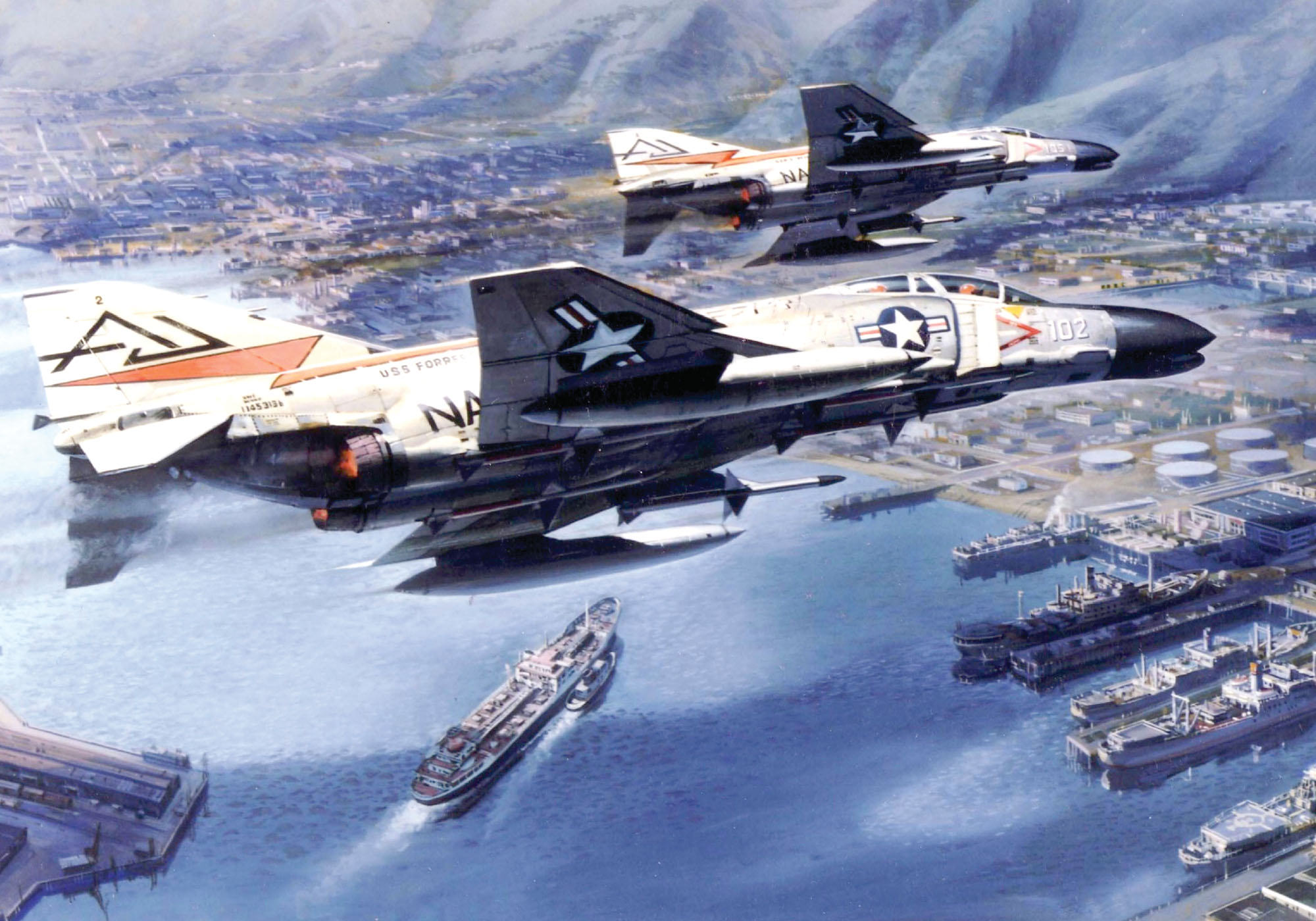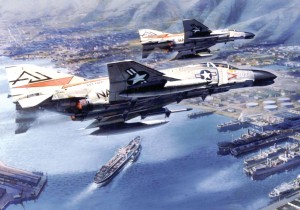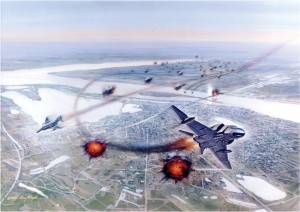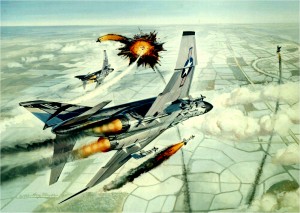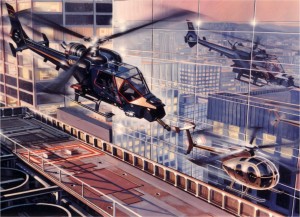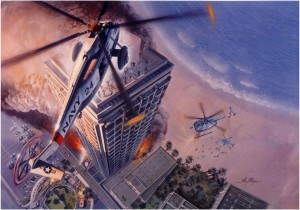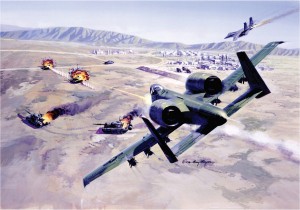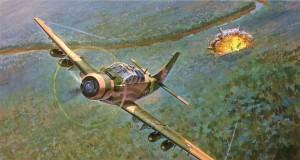By Stan Sears
In 1968, one way for an aviation artist to get a pilot’s perspective of the Vietnam War—not to mention the thrill of a lifetime—was to ride in the backseat of a F-100 Super Sabre on a combat mission.
That’s what Gary Meyer did, experiencing some of the gut-wrenching excitement, dangers and fears of combat flying in order to come away with an emotionally honest and authentic point of view about what it was like to go to war in some of the aircraft he illustrated.
That quest for visual and emotional accuracy resulted in Meyer’s flying several types of aircraft, on nine missions in Vietnam, and typifies the integrity he brings to all of his art.
Meyer’s interest in aviation originally led him to join the Marines right out of high school; he served in Korea during the Korean War as an aviation electronics technician assigned to the First Marine Air Wing. During that time, he made many drawings of military aircraft and added them to his portfolio, which he was preparing for acceptance to art school.
When he graduated with honors from The Art Center College of Design in Los Angeles, in 1959, his love and knowledge of airplanes caused him to pursue a career in aviation art. That decision was noteworthy in light of the fact that at that time no genre for aviation art even existed; he was advised by all but his conscience to consider other more likely artistic endeavors. Luckily for the genre-to-be, he followed his instincts.
One of his first jobs was with North American Aviation as an illustrator for the Apollo program. Being involved with America’s greatest adventure of the century—going to the moon and back—was extremely exciting and rewarding. He created a series of 40 illustrations that were photographically edited into a film that depicted one of the planned lunar missions, from liftoff to moon landing to reentry.
It differed from the ultimate real missions only in that it portrayed one of the early plans to have the Apollo Command Module land in the desert rather than the ocean. The idea that he was contributing to an important project that was not war-related was also very appealing. Throughout his career, Meyer’s love of illustrating military aircraft was always at odds with his abhorrence of war.
In the following years, his career expanded to include nearly every type of illustration that an artist can do, but aviation art remained a constant. From the time he left art school he did freelance art, even when he was employed in the corporate world or was running his own graphic arts business.
To survive as a freelancer, an artist has to be extremely versatile, and Meyer’s areas of expertise became increasingly diversified. His work carried him into the movie industry as a motion picture illustrator, where he did story boards, set illustrations and posters for Columbia Pictures and Universal Studios. The studios tapped his rich imagination for visual ideas about futuristic cities, spacecraft, weapons, garb, vehicles and life in general in several imagined futures. He created much of the continuity art for the soon-to-be legendary movie, “Star Wars,” thereby earning an artistic niche in the history of motion pictures.
Creatively related to the work Meyer did for motion pictures are the theme park concepts on which he has worked. In the 1960s, when movie studios were in a slump, Universal Studios in Los Angeles turned a huge portion of their lot into a now famous amusement park. At the same time, the Six Flags organization in Texas decided to develop theme-oriented amusement parks all over the country.
Meyer was hired to do extensive concept development for both of these companies, putting his ideas into architectural and topographical illustrations that were the imaginative core of many of the extraordinary theme parks now well known across the nation.
In another area, Meyer became famous for his aerial views of buildings and cityscapes, beginning with his sensational, award-winning album cover illustration for the rock band Chicago. Relying on his mastery of perspective, he painted a dizzying aerial view of the city’s Marina City apartment buildings, cleverly morphing them into the shape of the band’s logo, a stylized lettering of the word Chicago.
The album’s artistic success resulted in further commissions from many ad agencies to illustrate various products depicted as part of an aerial view of a cityscape, all which were noted not only for their imaginative portrayal of the products, but also for the their remarkably detailed accuracy. Meyer says that these aerial views are, in a sense, simply aviation art, except that the viewer is in the aircraft.
In addition to his commercial successes, Meyer has excelled in many areas of fine art, including portraiture, still life and sculpture. He has lectured on illustration to students and teachers at several universities across the country, and his work appears in eight art books. His art and illustration awards number in the dozens, and certificates of distinction and merit number well over 100.
He was a member of the prestigious New York Society of Illustrators, and is a past president and vice president of the equally eminent Society of Illustrators Los Angeles, in which he also served at least once in every office. In aviation art, he has been honored in the annual Experimental Aircraft Association awards, and is a recipient of the Founders Award from the American Society of Aviation Artists, of which he is also an artist fellow. He has served as a judge on several aviation art exhibits and as a member or moderator for ASAA Forums.
F-4 Phantom
The incredibly versatile F-4 Phantom was the workhorse of all branches of military aviation for 38 years. It was the first military multi-service aircraft built by the U.S., serving from 1958 until 1996, and holds the record for the largest production run of any supersonic fighter built in this country.
It flew concurrently with the U.S. Navy, Air Force and Marine Corps, and was simultaneously chosen by both the Navy’s Blue Angels and the Air Force’s Thunderbirds for their precision flight demonstrations. F-4s flew combat missions in both the Vietnam War and Desert Storm, and still fly in the defense of several foreign countries.
This outstanding service record has made the Phantom one of the most popular aviation subjects among illustrators. The two F-4s shown in one of Meyer’s creations shows the aircraft flying over a busy harbor from the aircraft carrier “USS Forrestal” (CVA59), in a painting done for the Garrett Corporation.
He also painted one depicting a flight by present California Congressman Randy “Duke” Cunningham, a Navy pilot who was the first fighter ace of the Vietnam War.
Another depicts the events of May 10, 1972, which marked the opening day of “Linebacker,” a highly classified combined Navy and Air Force operation that resumed bombing raids against North Vietnam. A prime target was the notorious Paul Doumer Bridge, spanning the Red River in the city of Hanoi.
The airborne weapons used against the bridge that day included new laser-guided bombs (LGBs) that were dropped from Phantoms flying in pairs. One of the pair carried a Pave Knife laser designator pod, which had to be kept pointed at the target until the bombs released from both planes struck home—no mean feat when you were receiving heavy ground fire.
Meyer was commissioned to do his illustration for the dust jacket of a book about the attack. The painting depicts Rick Hilton, a pilot with the Air Force’s 8th Tactical Fighter Wing, flying his Phantom in a sweeping, supersonic climb over Hanoi after dropping LGBs on the bridge.
Meyer’s earnest attempt to always “get everything right” paid off in a personally rewarding way with this illustration. The overall accuracy of the action, planes, weather and locale that his illustration captures is such that a group of veteran pilots at an ASAA forum voted it “most likely to have been painted by a fighter pilot.”
F/A-18E Super Hornet
In 1974, the rising costs of the F-14 Tomcat caused the U.S. Navy to seek a newer, low-cost, lightweight, long range, all-weather fighter/bomber. The result was the twin-engine F-18 Hornet, which first flew in 1978, followed later by the E and F versions (single-seat and 2-seat respectively) in 1995.
This aircraft finally evolved into the ultimate expression of leading-edge aircraft technology, the current F/A-18 E/F Super Hornet, a multi-mission strike fighter/bomber armed with a 20mm cannon and a full complement of “smart” air-to-air and air-to-ground weapons, including laser-guided bombs.
Larger than the original F-18, it has room enough to allow installation of future technology upgrades well into the 21st Century. The Super Hornet depicted in Meyer’s creation in an attack on shipping was done for a video game package.
Supermarine Spitfire Mk XII
The British Spitfire was one of the best, and best-known, fighter aircraft of World War II. Along with the Hawker Hurricane, it helped win the Battle of Britain in 1940, and through a long series of modifications called “Marks” (Mk) continued to distinguish itself throughout the remainder of the war.
The plane began as a pontoon racer, the S6B, which won the final Schneider Trophy Race in 1931. By the late 1930s, with war looming, the British Air Ministry had already developed the plane into the famous configuration which, visibly at least, would change but little throughout the war.
Most distinguishing, perhaps, were the unique, elliptically shaped wings, a brilliant design that combined the long span required for high altitude efficiency with the structural advantages of a short span, due to so much of its area being carried inboard.
In a history of development unequaled by any other plane, the Spitfire was continually improved to remain competitive with its contemporaries throughout its service. Meyer’s illustration shows a Griffon-powered Mk XII clipped-wing variant intercepting a German V-1 “Buzz Bomb” as it crosses the English coastline.
“Blue Thunder”
In 1983, Columbia Pictures released “Blue Thunder,” a techno-thriller about a fictional state-of-the-art military helicopter intended to be used to surprises urban violence.
The story was set in Los Angeles, where the movie was also filmed. Most of the action scenes took place 50 feet above street level among the actual buildings of downtown LA. “Blue Thunder” was the nickname for the helicopter, which was a modified version of the French SA342J Gazelle, a single-turbine, 200-mph light utility machine featuring the then-unique Fenestron shrouded tail rotor design. The modifications were mostly Hollywood prop gimmicks to make the helicopter look super-advanced and menacing, the most prominent one being a moveable, six-barrel, 20mm minigun. Filming took place on weekends; police cordoned off as many as 12 city blocks at once for three minutes at a time while the action was filmed. No doubt, many LA residents remember the traffic tie-ups as well as the incredible helicopter maneuvers taking place above the streets.
Meyer was on scene for much of the filming, in order to get a firsthand look at the action. His illustration was commissioned by a toy manufacturer for use on packaging, and shows the famous “chase scene” from the movie.
SH-3 Sea King
On New Years Eve, Dec. 31, 1986, the Dupont Plaza Hotel and Casino in San Juan, Puerto Rico, suffered a disastrous fire, in which 97 people died.
Stationed on nearby Vieques Island was the Navy’s Fleet Composite Squadron Eight (VC-8), a famous Sea/Air Rescue (SAR) squadron known as the Redtails. VC-8 launched three helicopters on short notice to fly to the hotel to assist with the rescue efforts, and the Redtails rescued 75 persons stranded on the roof of the hotel in twilight and darkness.
The helicopters used were Sikorsky SH-3 Sea Kings, a trusted steed that had seen distinguished service in Vietnam and Operation Desert Shield/Desert Storm, where 36 of them logged over 5,000 hours conducting various operations such as mine hunting, logistics support and SAR.
The SH-3, first flown in 1960, was the first helicopter to incorporate an automatic blade fold system to facilitate easier storage on aircraft carriers. Meyer’s illustration, done for “Readers Digest,” used a dramatic overhead view to show one of the Sea Kings approaching the hotel roof to lift people to safety.
A-10 Thunderbolt II “Warthog”
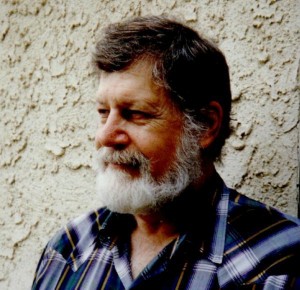
In order to come away with an emotionally honest and authentic point of view, Gary Meyer has experienced some of the gut-wrenching excitement, dangers and fears of combat flying.
In the mid-1970s, there was a need for a special aircraft whose sole mission would be close air support of ground forces. So singular were the many considerations required for this mission that the resulting design configurations produced an aircraft that looked downright ugly to the pilots who flew it.
The aircraft is the A-10 Thunderbolt II, affectionately nicknamed “Warthog” because of its less than graceful appearance. However, what it lacks in beauty it more than makes up for in performance. The A-10 has a range of 800 miles, and can fly up to 420 mph, day or night in any weather, with an excellent maneuverability at low air speeds and altitudes that makes it a highly accurate weapons delivery platform for attacking all ground targets.
Its avionics include highly sophisticated communication, navigation, flight control, fire control and weapons delivery systems, as well as target penetration and night vision aids. The A-10’s armament consists of a 30mm seven-barrel Gatling gun in the nose, and 16,000 pounds of mixed ordnance slung on eight under-wing and three under-fuselage pylon stations. It can carry 13 different types of bombs, missiles, mines, flares and electronic and infrared countermeasure devices.
The A-10 is also highly “survivable,” with self-sealing fuel cells, a cockpit protected by titanium armor, a redundant flight-control system, and an airframe structure that can absorb direct hits from armor-piercing and high explosive projectiles. In Operation Desert Storm, it proved itself a most formidable weapon. Meyer’s illustration, which was done for a video game package, shows an A-10 attacking several tanks in an imaginary desert war.
A-1E Skyraider
Because of its ability to carry large bomb loads, absorb heavy ground fire, and fly for long periods at low altitude, the A-1E Skyraider was particularly suited for close-support missions. Meyer painted himself into the copilot’s seat in his creation depicting a flight by an A-1E of the VNAF (South Vietnam Air Force).
Rewards
Most rewarding of all for Meyer is his current position as an instructor back at his alma mater, the famous Art Center College of Design in Pasadena, Calif. Since 1989, he has given up all other artistic endeavors in favor of dedicating himself totally to the challenge of passing on his talent and knowledge to the eager students in his classes.
Professional acknowledgement of his successes has been extremely gratifying, but he is proudest of all to be highly esteemed by his students, who have 14 times voted him the school’s Great Teacher Award, the last seven times consecutively.
In going full circle so successfully, Meyer rightfully considers himself an artist fulfilled.











